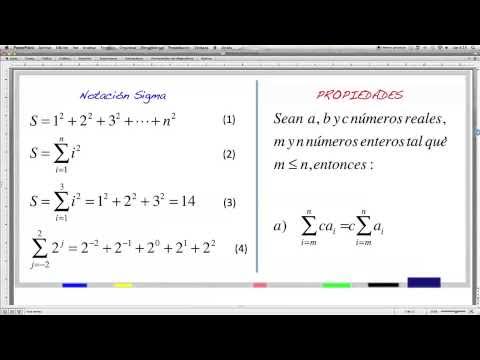Barisan Deret ( Notasi Sigma )
Summary
TLDRThis video explains the concept of Sigma notation, a shorthand for expressing summation operations. The instructor covers the components of Sigma notation, including the index, upper and lower bounds, and the summation formula. Several properties of Sigma notation are demonstrated with examples, such as how constants can be factored out, how sums can be split, and how boundaries can be adjusted. Through step-by-step examples, the audience gains a deeper understanding of applying Sigma notation for summing sequences or expressions, facilitating mathematical operations more efficiently.
Takeaways
- 😀 Sigma notation is used to write summation operations concisely.
- 😀 The sigma symbol (Σ) represents a sum, where the index (i) starts from a lower bound and ends at an upper bound (n).
- 😀 The index (i) represents the position of each term in the sequence, and the value of each term is represented as U(i).
- 😀 The lower bound (1) and the upper bound (n) define the range of the summation, and the summation adds the terms U(1), U(2), ..., U(n).
- 😀 For example, Σ (i=1 to 4) 2i results in the sum of 2, 4, 6, and 8, which equals 20.
- 😀 When the summation involves a constant, Σ (i=1 to n) a results in n * a, where a is the constant.
- 😀 If a term in the summation is multiplied by a constant, that constant can be factored out of the summation.
- 😀 For example, Σ (i=1 to n) 2i can be rewritten as 2 * Σ (i=1 to n) i, which simplifies the calculation.
- 😀 The distributive property allows summation of two terms to be separated. For example, Σ (i=1 to 3) (3i + 4i) can be split into two separate sums.
- 😀 Changing the limits of summation is possible, where the starting and ending indices can be adjusted by the same amount, but the index variable must be adjusted accordingly.
Q & A
What is sigma notation?
-Sigma notation is a shorthand mathematical expression used to represent the sum of a sequence of terms. It allows you to write the sum of a series in a compact form, using the Greek letter Σ to denote the sum and specifying the index and limits.
What does the 'i' represent in sigma notation?
-'i' in sigma notation is the index variable. It starts at a specific value, usually 1, and increases by 1 until it reaches the upper limit, denoted by 'n'. The index is used to represent the individual terms in the sum.
What do the lower and upper limits in sigma notation signify?
-The lower limit (usually 1) is the starting value for the index variable, and the upper limit (usually 'n') is the final value that the index will take before the summation stops. These limits define the range of terms to be summed.
How would you calculate the sum for Σ from i=1 to 4 of 2i?
-To calculate Σ from i=1 to 4 of 2i, you substitute the values of i from 1 to 4 into the expression 2i: 2(1) + 2(2) + 2(3) + 2(4) = 2 + 4 + 6 + 8 = 20.
What happens if a constant 'a' is multiplied by the summation expression in sigma notation?
-If a constant 'a' is multiplied by the summation expression, it can be factored out of the summation. For example, Σ from i=1 to n of a*U_i is equivalent to a*Σ from i=1 to n of U_i.
How does sigma notation handle summation when the terms are constants?
-When the terms in sigma notation are constants, the result is simply the constant multiplied by the number of terms. For instance, Σ from i=1 to 3 of 4 is equal to 3 * 4 = 12.
What is the result of Σ from i=1 to 3 of (3i + 4i)?
-The sum Σ from i=1 to 3 of (3i + 4i) can be split into two separate sums: Σ from i=1 to 3 of 3i and Σ from i=1 to 3 of 4i. This results in (3+6+9) + (4+8+12) = 18 + 24 = 40.
Can sigma notation be used for both addition and subtraction?
-Yes, sigma notation can be used for both addition and subtraction. The properties discussed apply to both types of operations, allowing you to split sums and adjust constants in similar ways.
What does the shifting of indices in sigma notation mean?
-Shifting indices in sigma notation means adjusting the lower and upper limits of the summation while also modifying the index variable accordingly. For example, if you change the lower limit from 1 to 0, the upper limit must also be adjusted, and the terms inside the sum might change as well.
How would you change the summation from Σ i=2 to 6 of 3i into a shifted version?
-To shift the summation Σ from i=2 to 6 of 3i, you could subtract 1 from both the lower and upper limits, changing the limits to i=1 to 5. The index inside the summation would also shift, adjusting the terms accordingly.
Outlines

This section is available to paid users only. Please upgrade to access this part.
Upgrade NowMindmap

This section is available to paid users only. Please upgrade to access this part.
Upgrade NowKeywords

This section is available to paid users only. Please upgrade to access this part.
Upgrade NowHighlights

This section is available to paid users only. Please upgrade to access this part.
Upgrade NowTranscripts

This section is available to paid users only. Please upgrade to access this part.
Upgrade NowBrowse More Related Video

Notasi Sigma Matematika Kelas 11 • Part 1: Pengertian Notasi Sigma

SUMMATION NOTATION || GRADE 10 MATHEMATICS Q1

01. Notación sigma (Sumatorias) ¿qué es? ¿cómo se usa?

NOTASI JUMLAH - MODUL 1 KB 2 STATISTIKA PENDIDIKAN PEMA 4210

GENERATING PATTERNS IN SERIES || GRADE 10 MATHEMATICS Q1

Calculo Integral 03: Notación Sigma. Sigma notation.
5.0 / 5 (0 votes)